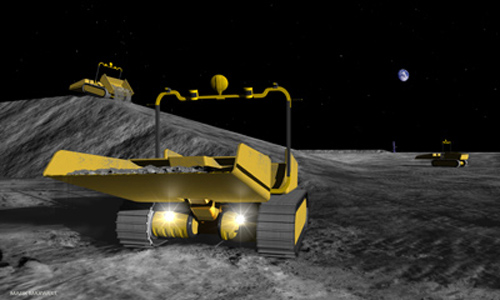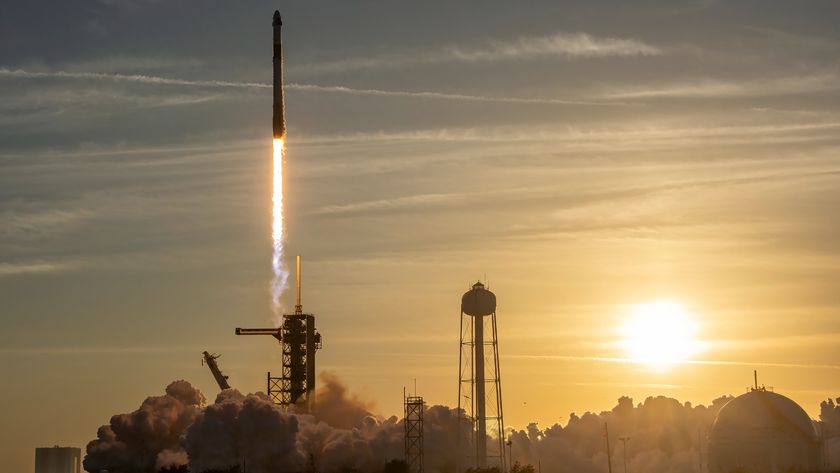
This story is part of a week-long SPACE.com series on what it would take for humanity to return to the moon to stay. Coming on Monday: 21st Century Moon bases and the new moon race.
The moon has water, and lots of it. Permanently shadowed craters at both poles have likely been trapping and accumulating water ice for billions of years, recent research has shown.
These concentrated stores are a precious resource that could revolutionize space travel, some scientists and entrepreneurs have argued. Lunar ice can be mined, split into its component hydrogen and oxygen and transformed into rocket fuel, which could then be sold to spacecraft from orbiting "gas stations."
Such an arrangement could spur a wave of space travel and exploration, the argument goes, since spaceships wouldn't have to lug all the fuel they need from Earth.
One firm that wants to make this happen is Shackleton Energy Co. SEC is serious; it plans to launch robotic scouting missions to the lunar poles within four years, and hopes to be selling propellant in orbit by the end of the decade.
In an e-mail interview with SPACE.com, SEC's founder, Bill Stone, talked about how lunar ice can open the solar system to humankind, how his company plans to mine and process this resource — and what the moon may look like 20 years from now. [Gallery: Our Changing Moon]
SPACE.com: You've said that water will open the heavens like gold opened the American West. Please explain what you mean by that.
Get the Space.com Newsletter
Breaking space news, the latest updates on rocket launches, skywatching events and more!

Bill Stone:It costs about $10,000/kg [$4,545 per lb] to launch most "business-class"payloads into low- Earth orbit (LEO), except for the space shuttle, which is tremendously more expensive. New breakthroughs in physics and/or economy must be realized to significantly reduce this high cost; however, none appear to be on the horizon.
A major issue in making access to space cheaper is that every space mission must carry its own fuel for in-space operations, since in-space refueling does not currently exist. Even if it did, that fuel would have to be lifted and stored on orbit in fuel depots at even higher prices. To avoid this high-cost barrier to real progress, a means to provide cheaper propellants in space has to be developed. We have the answer: water-derived propellants from the moon.
Since water is abundantly available on the moon, as corroborated by recent NASA observations, it can be harvested, transported to LEO and converted to liquid oxygen and liquid hydrogen propellants to be sold commercially at much lower prices. Our analysis shows it is about 15 times cheaper to launch any mass from the moon to LEO than from the Earth.
Lower-cost propellants in space will transform access to and invigorate operations in space. Importantly, our business model indicates this can be realistically done within the decade. Launch providers will now be able to use smaller, cheaper launch vehicles that do not carry excess fuel. They can now get that extra fuel from our orbiting "gas stations." What is very encouraging is that current space treaties and law permit commercial operations on the moon, so the opportunity is wide open to anyone.
Why can't governments do this job instead? Governments alone do not have the mandate, the will, the collective funds, or the risk models to do this job affordably, efficiently or quickly. Therefore, industry must step in to lead and for others to follow as beneficiaries. SEC intends to provide this quality service at least a decade ahead of what governments are only contemplating today.
Although the demand for the propellants is currently not well-defined, the convergence of science, security and commercial interests (especially space tourism, orbital debris cleanup and satcom servicing/refueling) in space will accelerate that demand if low-cost propellants are available. Much like gold opened the West as a magnet to a better quality of life and opportunity for many people, we see the same happening with unlimited access to cheaper propellants in space. If successful, our venture will truly be the next Gold Rush (albeit a liquid one in space) that will bridge the gap by providing more affordable access to and operations in space.
SPACE.com: You've been thinking seriously about mining the moon for nearly 20 years. Do you feel like this idea's time has finally come? If so, why? What has changed?
Stone: Yes, the timing is perfect. Here's why. Five important factors have converged to warrant a full-fledged industrial-prospecting mission to the moon, followed by mining and propellant sales. [10 Coolest New Moon Discoveries]
1. Supply: There is a high likelihood that huge quantities of freely available polar ice exist on the moon. Recent data from the LRO, LCROSS and Chandrayaan orbiters gives us high confidence that there are huge deposits (billions of tons as indicated by NASA) of ice in the cold trap craters of the lunar poles. If true, these ice fields represent extremely valuable mining opportunities.
2. Demand: Interest in going to space is expanding rapidly, especially for exploration, science, satellite servicing, orbital cleanup and tourism. Excessively high launch costs have limited business expansion. With much lower in-space propellant cost, business operations can expand and enable opening the NewSpace transportation highway system.
3. Wealth: Many individuals and companies have accumulated massive amounts of wealth that could be applied to this new space enterprise. Because this is a "green energy play," investors should welcome the new opportunity primarily for the ROI [return on investment] and, secondly, for the opportunities for environmental and other spin-off opportunities that will invariably evolve.
4. Team: Heretofore, government-led space programs have paid exorbitant risk premiums for success, especially with human-rated systems. Today, an industry-led team can manage this risk privately and move much more quickly in the global marketplace to accomplish the mission. We have the experience and know-how to make this happen efficiently and affordably at least an order of magnitude cheaper than any government or government collective program in history.
5. Policy/Law: Relevant international treaties and law permit private exploration and harvesting of lunar resources, giving us the green light for the mission.
SPACE.com: What's a realistic timeline for when you could get orbital fueling stations up and running?
Stone:Within four years, we intend to launch two robotic lunar prospector (scouting) missions to both poles of the moon to selected, high probability, ice-laden craters.
Because of the extremely harsh operating environments, nuclear RTG [radioisotope thermoelectric generator]-powered rovers will perform prospecting operations for at least a year each in the ultra-cold, ultra-dark craters (we are talking of an area with a temperature of 40 degrees Kelvin [minus 387 degrees Fahrenheit, or minus 233 Celsius]). No other form of power can do the job effectively or affordably.
"Ore" maps will be developed to make follow-on business decisions. We will use NASA lessons learned and rover experience/technology as guides to developing our rovers.
If the prospecting is successful and financial decisions are favorable, we will then conduct a major systems engineering and risk reduction program leading to human mining missions on the moon in or near selected craters. In the risk reduction phase, we will deploy several orbiting work stations, wherein all the training, procedures and vehicle assembly will be conducted prior to human lunar insertion and landings.
Initially, a crew of 6-12 operators will be trained and deployed to the LEO stations to fine-tune all required operations. When risk reduction and training is complete, an initial crew of 6-8 will descend to the lunar surface mining area and set up camp. Subsequent missions will deliver all required equipment and consumables on a frequent basis in preparation for mining operations.
When the lunar camp is declared operational, human-tended industrial mining and processing operations will commence, leading to frequent transportation of water to our LEO processing stations. In these stations, the water will be converted, on demand, to propellants for point of sale. SEC will offer propellant sales worldwide to all spacefaring customers.
Initial operational sales are anticipated within the decade, given full funding is achieved on schedule. Customers will be scheduled for fueling operations according to internationally approved standard interfaces and practices.
We envision the first SEC fuel depot to be positioned close to the ISS [International Space Station] to make fuel access convenient. Later depots will be positioned at points co-located with evolving customer demands. Propellants and consumables will always be available for sale on the moon at our base camps.
SPACE.com: What will a Shackleton Energy lunar mining base look like?
Stone:Initially, the lunar operating base will be relatively small to accommodate about 6-8 crew for 24/7 operations. The startup crew may have to spend a year on the moon. Operations crews will subsequently be staged at 6-month intervals for normal operations, but we will have frequent transit flights back and forth to LEO/moon for resupply, contingency and medical issues.
We will employ maximum use of inflatable structures for the habitat and modular high-power nuclear power supplies for all power operations (heating and electricity). The operations concept calls for human-tended robots to do most of the mining, transportation and processing functions with minimal EVAs [extra-vehicular activity]. The base camp will be expanded incrementally to accommodate increased operations as fuel demand increases. We envision providing at least four very large fuel transfers per year to LEO.
SPACE.com: Who will your customers be? Mainly government agencies, private companies or both?
Stone: All of them. Initially, we envision government space agencies (e.g., U.S., Russia, China, India, Pakistan, South Korea, Japan) will purchase long-lead propellant contracts with us, followed by private companies for space repair, satellite refueling and space tourism. We eventually plan to be able to provide enough fuel for round-trip missions to other locations in space (e.g., Mars, asteroids) as the customer base arises.
Since we will already have established mining camps at both poles and have the infrastructure to expand, we will offer contracting services to governments, science and commercial entities setting up camps elsewhere on the moon as a for-fee service, much like big industrial service providers (e.g., Haliburton, KBR, Dyncorp, Fluor). When operational, our pipeline supply chain management services will operate very efficiently, much like FEDEX/UPS today. With even more customers conducting LEO operations over time, the "system" becomes even more efficient for all.
Very recently, Bigelow Aerospace announced it was entering negotiations with several foreign governments to buy or lease Bigelow space stations. This is exactly what we had hoped for and strongly encourage to expand the market for space services. In addition, having abundant fuels and transport vehicles on the moon gives us on-demand flight access and mobility to any point on the moonfor a variety of customers or reasons. We expect demand to grow slowly, then to expand exponentially within 10 years of commercial operations in LEO. The largest consumers downstream we believe will be in space tourism followed by government human exploration programs.
SPACE.com: What are the biggest hurdles to making all of this happen? Are they technological, financial or political?
Stone: All of the above. Here are the top two.
1. Access and permits to launch nuclear power supplies to the moon directly. We have already started coordination with the White House (Office of Science and Technology Policy) to get support for U.S. nuclear power systems (NPS). Alternative sourcing internationally is also being considered due to the scarcity of NPS materials in the U.S. — first low-powered RTGs for robotic prospecting, then high-power fission NPS for human exploration, mining and processing on the moon.
Alternative sourcing internationally is also being considered due to the scarcity of NPS materials like Pu-238 [plutonium-238] in the U.S. In addition, as a matter of national urgency, the U.S. should restart production of Pu-238, purchase the remaining Pu-238 from the Russians, and accelerate production of alternative-powered RTGs with radioactive isotopes that are abundantly available domestically and internationally.
Without a concerted U.S. effort to build up NPS sources and rapidly evolve new NPS systems, it will place itself in a very disadvantageous position when NASA, international partners and commercial businesses like ours need the support.
Waiting 4-7 years for the U.S. process to provide the service and obtain permits to launch from the U.S. makes no sense in today’s rapidly expanding space markets. Obtaining NPS support is crucial early on in the business-planning phase. Without nuclear power, lunar resources like water will not be extractable for many decades, thus unnecessarily delaying man’s expansion off Earth.
2. Obtaining sufficient funding from predominantly private investors for the life of the program. This requires a unique, nontraditional investor mentality that can deal with the high risk associated with this transformational business opportunity.
We are looking at mega-net-worth individuals who want to change history, very large corporations, energy consortia/syndicates and geographically matched nation-states wanting to become spacefaring centers of excellence on the fast track.
SPACE.com: How much will such a venture cost, and how will your company be able afford it?
Stone: Preliminary estimates are about $25 billion to reach the point of positive ROI following initial operations in LEO. Of course, this estimate will be refined once the main program segment commences. With regard to the second half of the question, we will have four program phases of increasing complexity and capability leading to uncertainty reduction and sustainable, high-confidence operations. Each phase will require increasing levels of tranche funding from the investment community. The levels of funding being discussed are on par with current large industrial terrestrial energy projects like Ekofisk in the North Sea.
We very much appreciate NASA’s Dec. 19, 2010, paper, "Mission and Implementation of an Affordable Lunar Return,"that further confirms our industrial value proposition for human exploration and resource extraction from the Moon. NASA's detailed analysis shows a larger and more ambitious program taking approximately 15 years and $87 billion. The timing of this important report strongly supports our commercial estimates and business case.
SPACE.com: What would you say to people who worry that commercial exploitation of the moon could compromise its importance as a research resource and a record of the early solar system?
Stone: With a global surface area of over 35 million square kilometers [13.5 million square miles], with proven reserves of over a billion tonnes of water ice, and with the likelihood that initial surface resource processing will be done in relatively small, localized crater areas, it is unlikely that lunar return and resource harvesting will even be detectable to other lunar explorers, scientists or users.

To put this in a more practical perspective, the lunar north pole water alone (from LRO radar signature) is enough to launch one shuttle equivalent per day for over 2,300 years. But this is, literally, only the tip of the "iceberg."If the LCROSS data are correct and the ice zone extends as far as the area between each of the poles to a circle at 80 degrees latitude, there is likely to be enough ice on the moon to launch, again at one-per-day, an equivalent shuttle launch for 250 million years.
The moon is a large body with lots of room and lots of resources. There is space enough for everybody on the moon for whatever purposes they envision.
Lunar water is absolutely critical to opening up the frontier of space. By harvesting it, we begin the process of "cutting the cord" with the Earth and learning how to supply and provision ourselves from the virtually limitless material and energy resources of the solar system. If humanity is to have any future beyond Earth, we must learn how to responsibly extract and make what we need in space from what we find there. The moonis near, accessible and possesses the resources we need to learn these skills.
SEC recognizes that we have a unique opportunity to set a precedent of good stewardship on the moon. In line with our philosophy of responsible human expansion into space, SEC intends to conduct its business on the moon in a manner that is conscientious of the environment and considerate of others who may wish to do business on the moon, especially scientists. To this end, we will coordinate with leaders working in lunar research to establish best practices for extracting the moon's material resources.
SPACE.com: What do you think the moon will look like in 20 years? Will there be lots of different resource-extraction operations, research bases and even tourist developments?
Stone:It is hard to imagine today, but as SEC's successes mount, the moon will become a realistically accessible place for science, security and commerce applications. It could also become the No. 1 tourism destination for the wealthy. However, it will be SEC's policy from the start that our products will be made available on an equal basis to all paying customers. We hope to be able to help all those in need of resources and support both in LEO and on the moon.
Realistically, the moon will remain a remote, hostile and unforgiving place for the foreseeable future. Those who will go there will still do so at great personal risk. But it will cost less to reach and the frontier will open dramatically with ice-derived propellants.
We would expect that within 20 years there will be a few remote mining outfits on site, like SEC, an international government-funded scientific outpost and perhaps one or more facilities dedicated to space tourism or space manufacturing.
Without efforts such as we are proposing at SEC, the next 20 years will be as dull and predictable as the last 40 years with regard to activities and access to the moon. There are limits to the activities a government can do on the moon that will be of sustainable value and economic return to those on Earth, and this is not going to change.
What has stalled government space programs of all nations is that they are inherently negative ROI undertakings. There is an initial infatuation with demonstrations of nation-state technological prowess, but a nation can only afford that highly expensive game for so long. SEC has, over the last 15 years, painstakingly put together a defensible positive ROI business for the moon and near-Earth space.
The excitement and promise felt and embraced with the first moon landing in 1969 has been dormant for too long. At this moment in history, the combined talents, resources, technology, finances and opportunity are readily available to bring those old dreams of the space frontier back to humanity's center stage.
We'd say that the next 20 years look pretty bright.
You can follow SPACE.com senior writer Mike Wall on Twitter:@michaeldwall.
Join our Space Forums to keep talking space on the latest missions, night sky and more! And if you have a news tip, correction or comment, let us know at: community@space.com.

Michael Wall is a Senior Space Writer with Space.com and joined the team in 2010. He primarily covers exoplanets, spaceflight and military space, but has been known to dabble in the space art beat. His book about the search for alien life, "Out There," was published on Nov. 13, 2018. Before becoming a science writer, Michael worked as a herpetologist and wildlife biologist. He has a Ph.D. in evolutionary biology from the University of Sydney, Australia, a bachelor's degree from the University of Arizona, and a graduate certificate in science writing from the University of California, Santa Cruz. To find out what his latest project is, you can follow Michael on Twitter.











